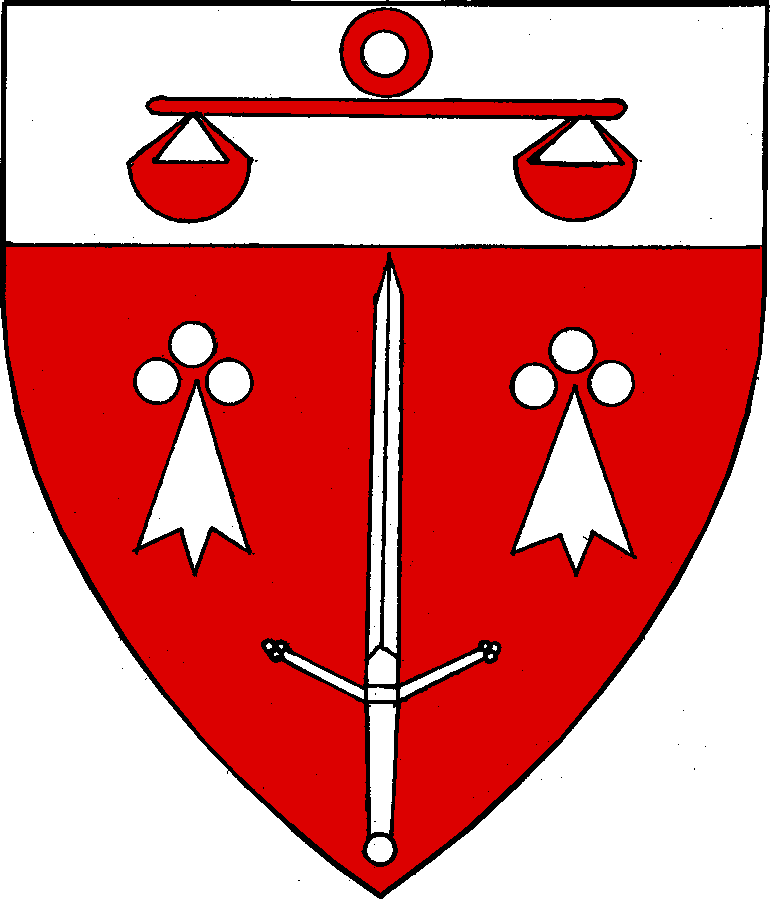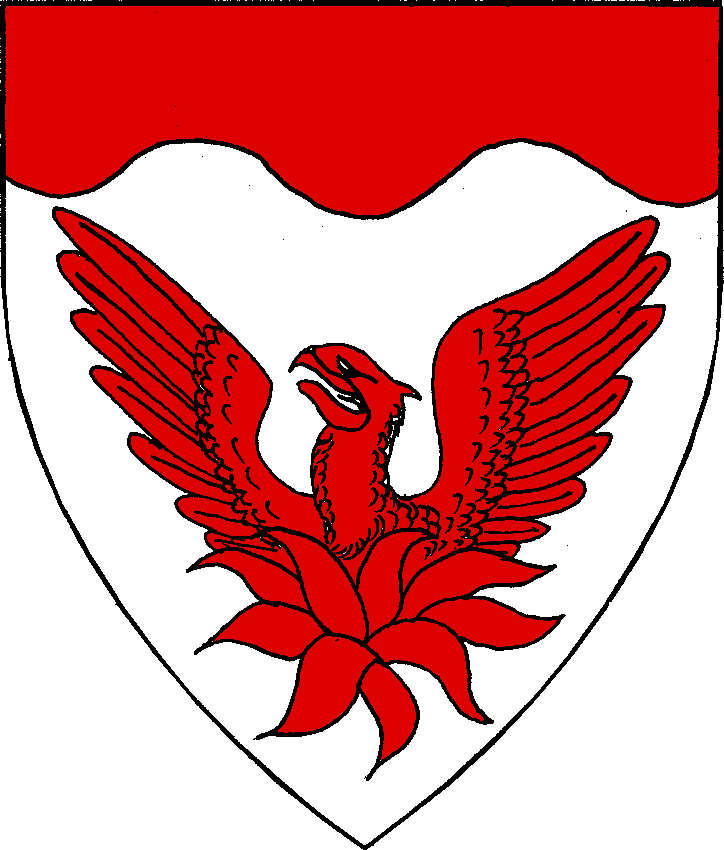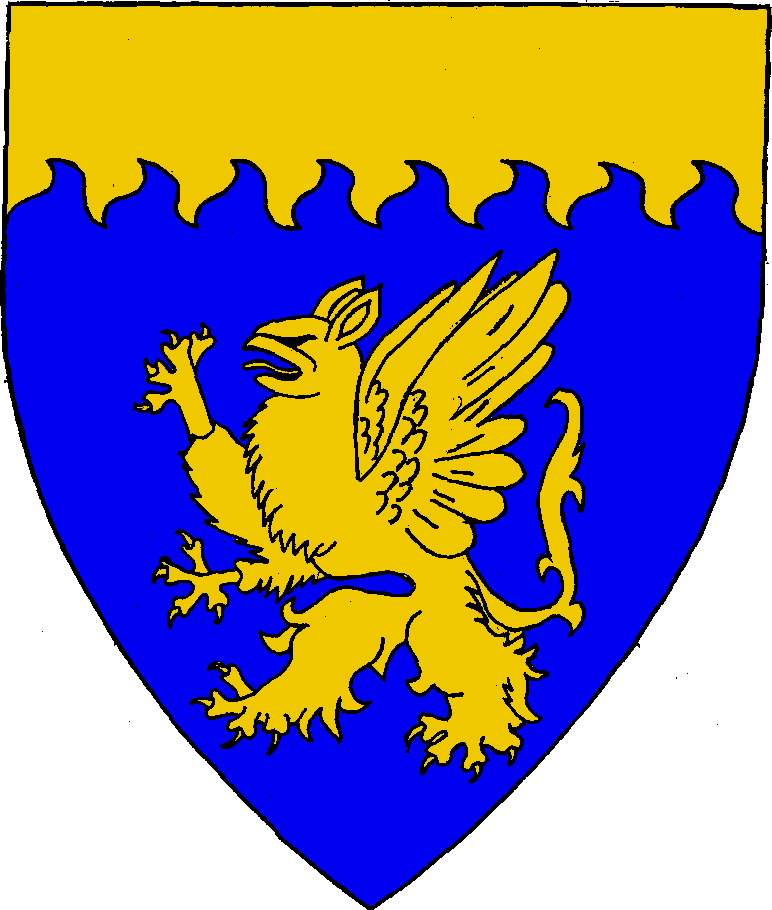


Crux Australis Herald
Baron Uberto Renaldi [mka Nigel Castle]
GPO Box 2719, Adelaide SA 5001, Australia
phone: (08) 8336 6791 or intl +61 8 8336 6791
 |
Crux Australis Herald
|
"The CAMeL"
November 2001 (Anno Societatis XXXVI)
Unto the College of Heralds of the Principality of Lochac, and all others who may read this missive, from Baron Uberto Renaldi, Crux Australis Herald, greetings!
In this issue…..
Reports | Position vacant - education deputy | Do we need internal commentary?
Roster changes | Important addresses | Subscriptions and Resources | Submission requirements
Meeting schedule | Recent submissions | News of previous submissions
November Coronet thanks
My profuse thanks to those who assisted with the field heraldry at Lochac’s final Coronet Tourney: Aeddan, Amber, Cormac Lenihan, Will Dekne, Gwynfor Lwyd, Morna of River Haven, Raulin de Northwode, Ute von Tangermünde and anyone else I’ve missed.
I would especially like to thank Declan of Drogheda, who volunteered his voice and also organised much of the voice heraldry at the event. My thanks also to Ute von Tangermünde and Hanbal al-Barbari for accommodation, sustenance and transport.
In case you haven’t heard yet – Gawain won the tourney, inspired by Yve d’Angely, besting Loyola Juan Sanchez Mendoza (fighting for Elayne Montjoy) in the final. Gawain and Yve will be invested as Lochac’s 36th and final Prince and Princess at Twelfth Night in Agaricus (in AS 36 – tell me that’s just coincidence!)
Your servant,

Baron Uberto Renaldi,
Crux Australis Herald
The next quarterly reports are due by 2 December 2001, about a week earlier than previously published due to the combination of the silly season and my trip overseas in January.
Position vacant - education deputy
A reminder that I am seeking a deputy responsible for the training and education of heralds and the populace in various areas of heraldry. Their responsibilities will initially include:
The job will require good written communication skills, a broad knowledge of heraldry (as practised in and out of the SCA) and the desire to impart that knowledge to others. Access to a computer and printer is essential (unless you can convince me otherwise) and access to email and the World Wide Web highly desirable.
Applications must be in writing and must reach me via post or email by 2 December 2001. I have so far received zero applications for this position. Surely there must be someone who wants to give this a go?
Do we need internal commentary?
Recently (well, a while ago actually), a proposal was raised on the blazons@sca.org.au email list by Will Dekne for the re-introduction of internal commentary on submissions (which is the reason I started the blazons list in the first place, but it never really took off).
Seeing as it is an important topic, here is his entire post verbatim.
I'd like to see a resurrection of what Peter the Uncertain attempted a few years back when he was Crux:
A position within the Lochac CoH should be created, with the responsibility for co-ordinating internal commentary. (Given Lochac's usually relatively low quantity of submissions, this position could be held by Crux Australis relatively easily. On the other hand, if Crux is feeling particularly pressured by the other paperwork he needs to get done, then it could be given to another individual.)
This new position (if different to Crux) should be the mail destination for new submissions (unless the person has easy access to Crux's mailbox). The holder of the position (if not Crux) would need to (amongst other things) be responsible for:(i) maintenance on the submission files;The person holding the position would, at a regular interval (presumably monthly), advise via e-mail to the blazons list what new stuff has come in, what evidence has been presented etc. (This would probably be best presented on a web page.) Then, after a suitable length of time, the person would collate whatever combined (useful) commentary has been received, and advise what should be sent to Laurel and what needs further work. (Hmm, I guess this means the position will also be responsible for mailing LoIs etc. Which may mean they need a bank account as well; or, at least, someone with disposable funds who can then apply to Crux for re-imbursement of postage costs etc. Hmm.)
(ii) possibly looking after the Crux heraldic library;
(iii) forwarding received monies to Crux (unless there's some legal obligation for a separate bank account? I would hope not!);
(iv) writing letters of acceptance and return (to the submitters) as required;
(v) sundry other paperwork as required.
Benefits of the proposal:
(1) It takes work away from Crux Australis. Admittedly it's one of the best parts of the job (sending out roster letters and reports certainly isn't!) but it's time-consuming. Note that Crux's responsibilities will increase, not decrease, once we become a Kingdom, although (heraldically-speaking) Lochac has been acting as a Kingdom for some time already.
(2) The Crux office needs a good paper-pusher. Separating the submissions from the job means that Crux need not be a super book herald as well. (Not that there's anything wrong if he/she is!)
(3) Doing commentary by e-mail allows for timely responses, and more importantly, allows for discussions. When I was Peter's submission herald, the biggest problem with the process was that those few people who commented weren't always able to articulate precisely their objections (or approvals!), and I in turn was not always in a terrific position to educate those who were making errors in their conflict calls, etc. The ubiquity of e-mail these days makes it easier for anyone sufficiently interested to participate, as well as making it simpler to weed out those comments not directly relevant to the submission.
(4) A sub-benefit of the above: with regular discussion comes education, for those so inclined. Even if you don't participate in an on-going discussion, just reading through it gives you familiarity with things you thought you'd never learn anything about. Trust me, it works!
Drawbacks of the proposal:
(1) It will be a Position of Responsibility, as money-handling of some sort will be required, timely work needs to be done, etc. It might be hard to fill it.
(2) Additional lines of communications may need to be set up (between Crux and the person in the position, between the position and Laurel, etc.). Could be fiddly. May also require bank account and so on. More fiddly stuff, if so.
(3) Will delay the submission process slightly, as some time (a minimum of 1 week; more would be better) will be required for the making, collating and interpretation of comments.
(4) The person will need access to a scanner & so on, and a web page to present submitted armory for others to look at. (Or to put it more simply, they need a web page, period.) This may be trivial or may be a big deal, depending on the individual's resources.
What do people think? Personally I think the overall benefits outweigh any disadvantages that I can think of.
I tend to agree with Will on this one, but it will only work if there are enough people prepared to contribute commentary on submissions.
No-one responded to this when it was posted to the email list, which doesn’t bode well. I would like everyone to consider commenting on this proposal (even just to say "I agree" or "it sucks"). Otherwise I will just assume that nobody gives a rat’s arse about how their College of Heralds functions (and will therefore eventually cease to function).
Ute von Tangermünde has successfully completed the PE test and the other requirements for advancement, so I am happy to roster her as Acting Goutte d’Eau Pursuivant with a personal rank of Pursuivant Extraordinary.
Eleanora de la Birche has also completed the PE test and has been added to the roster as a Pursuivant Extraordinary At Large.
Dieric Pieterszoon van Tholen has had to step down as Acting PE for the Shire of Borders Cross due to other commitments. Sadly, as he did not manage to attain a personal rank of PE I have been forced to remove him from the roster.
Crux Australis Herald: Uberto Renaldi [Nigel Castle] GPO Box 2719, Adelaide SA 5001. Ph (08) 8336 6791. Email herald@sca.org.au
Hund Herald (West Kingdom external commentary) and Bombard Pursuivant (Ceremonies deputy): Thorfinn Hrolfsson [Steven Roylance] 1592 Malvern Road, Glen Iris VIC 3146. Ph (03) 9885 6348. Email roylance@corplink.com.au
Canon Pursuivant (Precedence and Gentry list): ): Morag Freyser [Helen Brinsmead] PO Box 455, Woden ACT 2606. Email the_brinsmeads@dingoblue.net.au
Mortar Pursuivant (Education deputy): VACANT - PLEASE APPLY!
Rocket Pursuivant (New PE test): Aislinn de Valence [Megan Dansie] PO Box 526, Unley SA 5061. Ph (08) 8293 6635. Email aislinn@merlin.net.au
Baryl Pursuivant (External commentary): Thomas Flamanc of Kelsale [John Sawyer] PO Box 222, Flinders Lane Post Offices VIC 8009. Email sawyer@lexicon.net.au
Subscriptions and Resources
"The CAMeL" is available from Crux Australis at $20 per year. Make cheques payable to "SCA Inc. College of Heralds".
Laurel's Letter of Acceptance and Return is available from the SCA College of Arms. Send a cheque for $US25 made out to "SCA Inc. — College of Arms" to Bruce R. Nevins, 2527 E. 3rd Street, Tucson AZ, 85716-4114, USA. As usual, everything of relevance to Lochac will be published in "The CAMeL".
The Armorial and Ordinary, as well as updates to them, are available from ‘SCA Inc. - Free Trumpet Press West’ in the USA. Their address is ‘1613 N. School St., Normal IL 61761-1240’. They also sell the ‘Heraldic Pictorial Dictionary for the SCA’, proceedings of Known World Heraldic Symposia and Compilations of Precedents by past Laurel Sovereigns of Arms. Contact me or see details of their web site below.
I also recommend that groups acquire some name resources, in particular P.H. Reaney & R.M. Wilson’s ‘A Dictionary of English Surnames’ and E.G. Withycombe’s ‘The Oxford Dictionary of English Christian Names’. The latter is out of print, so if you spot it at a second-hand book sale, buy it!
Useful or interesting links:
The SCA Heraldry web page - www.sca.org/heraldry including the Laurel home page and on-line armorial and ordinary search.
The Academy of St. Gabriel (an heraldic consultation service) - www.s-gabriel.org
West Kingdom Heralds' Handbook - heralds.westkingdom.org
Free Trumpet Press West (SCA heraldic publications) - www.sca.org/heraldry/ftpw.
Parker’s Glossary of Heraldry - http://www04.u-page.so-net.ne.jp/ta2/saitou/ie401
Cost: $20 per new submission (name, device or badge). Note: a new name and device costs a total of $40. No cost for resubmissions or branch submissions. Make cheques payable to "SCA Inc. College of Heralds".
Copies required:
Please include ALL necessary documentation to support each submission. It is the responsibility of the submittor to present their submission in a way that makes registration easy. Name documentation should be as accurate as possible: remember to include photocopies of the title page as well as the relevent page(s) of any source used.
Crux Australis submission meetings are held once a month, usually at 36 Rosella Street, Payneham SA. Please call beforehand if you intend to bring submissions for processing. The next meeting is scheduled for Sunday 9th December at around 3pm, preceded by an heraldic workshop and followed by cocktails and festive merriment. Note that there will be no submissions processed in January due to my trip to the USA. The next meeting is therefore tentatively scheduled for Sunday 10th February.
Present at the Crux Australis Submissions Meeting held on Sunday 11th November 2001 at 36 Rosella Street, Payneham SA were: Baron Uberto Renaldi, Crux Australis Herald; Lord Grufydd ap Cynan, Acting Frette Rouge Pursuivant; Lady Massaria da Cortona, Pursuivant Extraordinary At Large; and Wakeline de Foxley, herald-in-training.
The following submissions have been FORWARDED to the College of Arms for registration:

Resubmission of Branch Name and Device to Crux
Per chevron purpure fretty Or and Or, in base a bunch of grapes purpure within a laurel wreath vert.
A previous submission of the branch name Borders Crossing and a device were both returned by me in November 2000 for a number of problems.
The group will accept major changes to the name, which is just as well because the new submission, Bordar’s Cross, also has problems: we could find no evidence of English placenames using apostrophes before 1600, nor that the word Bordar was in English used prior to 1776 (derived from Latin bordarii, plural of bordarius meaning "cottager".)
Fortunately, we were able to devise another name that sounds almost identical.
Ekwall states that the OE word cros was used as both a prefix and a suffix in English placenames. There is evidence of cros as a suffix in "Hoar Cross" (Horcros 1230) meaning "grey cross", and "Staincross" (Staincros 1086) meaning "stone cross". Further, Mills gives the placename "Pilgrims Hatch" (Pylgremeshacch 1483), meaning "a hatch-gate used by pilgrims", as evidence of names of the form <plural-noun + object>. Finally, the OED gives "boarder" (boorder 1530) as "one who boards, or has his food and lodging at the house of another..." and "bourder" (bourdour 1330, burdoure 1375, bordere 1499) meaning "a jester, a joker, a buffoon, a mocker." Therefore, we feel that the name Borders Cross (as a variant of Boorders Cross or Borderescros) is plausible as a late medieval placename, meaning either "cross used by boarders" or "cross used by jesters".
The device does may run afoul of RfS VIII.1.a (known as the ‘slot-machine’ rule). This is because there is a prior precedent that says that fretty and a fret were considered interchangeable in period. This means one could consider the primary charge group on this device as consisting of three charges of different types (a fret, a wreath and a bunch of grapes).
However, VIII.1.a states that "three or more types of charges should not be used in the same group" as a guideline, not an inviolate rule. Furthermore, previous submissions have treated fretty more as a semy of charges than as a single charge, implying it can in some instances be considered a secondary charge group.
This one was too thorny for me, so I have forwarded it on for Laurel to make the final decision. My gut feeling is that it will be returned, but I am required to submit it if I think there is a chance of it being registered.
Resubmission of Name to Crux
The submittor desires a feminine Spanish name and will accept minor changes, including "Catalina de la Gata" if necessary. Her previous submission of Catalina de Gatan was returned by me last month for insufficient documentation of Gatan as a byname.
Catalina is listed by both Smith and Van Stone [1] as a reasonably common feminine given name in late 15th century and 16th century Spain.
Gata (or la Gata) is listed by Boswell as the name of a small aljama (presumably a village) which had either 25 or 60 taxable persons in 1356, depending on who was asked at the time.

Resubmission of Device to Laurel
Gules, a sword palewise between two ermine spots, on a chief argent a balance gules
His last resubmission, of the same design, was returned by me in June 2001 as it was submitted on the wrong forms. Prior to that, his submission of Gules, a sword quillioned of balance pans argent, a bordure argent ermined gules, was returned by Laurel in June 2000 for redrawing.
This redesign appears free of problems.
New Name (see RETURNS for Device)
The submittor desires a masculine 15th-16th century Spanish name and will accept minor changes only.
Esteban is listed by Van Stone [2] as a 16th century Spanish masculine given name.
de Quesada is listed by Smith as a late 15th-Century Spanish locative byname.

New Device
Argent, a phoenix and a chief wavy gules.
The name was submitted to Laurel last month.
The following submissions were RETURNED for further work:

New Device
Sable, a valknut inverted argent.
It was the overwhelming feeling at the meeting that the way the valknut has been drawn - with the three triangles intersecting so as to form a three-armed "swastika" - could unintentionally cause offense due to the similarity with a symbol by several extremist groups, including pro-apartheid neo-Nazis in South Africa.
The device therefore violates rule IX.4: "Offensive Political Symbolism - Symbols specifically associated with social or political movements or events that may be offensive to a particular race, religion, or ethnic group will not be registered. Even if used without prejudice in period, such symbols are offensive by their modern context. Thus, designs suggestive of the SS, the Ku-Klux Klan, or similar organizations, may not be used."
It should also be noted that the valknut is an SCA-invented charge which may no longer be acceptable for registration (although there is no precedent specifically prohibiting its use).

Resubmission of Device to Laurel
Azure, a griffin segreant and a chief rayonny Or
This conflicts with Azure, a hippogriff segreant within a bordure rayonny Or, a badge registered to Micheal mac Tomas in May 1987 via the Kingdom of An Tir.
There is one CD for changing the bordure rayonny to a chief rayonny, but that’s all.
References cited
Boswell, John. 'The Royal Treasure: Muslim Communities under the Crown of Aragon in the Fourteenth Century'. Extracts webbed at 'The Library of Iberian Resources Online', http://kuhttp.cc.ukans.edu/kansas/aarhms/mainpage.htmlBR> Ekwall, Eilert. 'The Concise Oxford Dictionary of English Place Names'. 4th edition., Oxford University Press, 1991.
Mills, A.D.. 'A Dictionary of English Place Names'. Oxford University Press, 1991.
OED = Oxford English Dictionary. 2nd edition.
Reaney, P.H. and Wilson, R.M. 'A Dictionary of English Surnames'. Revised 2nd edition. Routledge London 1979.
Smith, Julia (aka Juliana de Luna). 'Spanish Names from the Late 15th Century'. http://www.s-gabriel.org/names/juliana/isabella
Van Stone, Kathy (aka Elsbeth Anne Roth).
[1] '16th-century Spanish Women's Names'. http://www-2.cs.cmu.edu/~kvs/fnames.html
[2] '16th-century Spanish Men's Names'. http://www-2.cs.cmu.edu/~kvs/mnames.html
Lochac submissions from the August 2001 Letter of Acceptances and Returns:
REGISTERED
Alethea of Shrewsbury. Device change. Purpure, on a lozenge argent a fleur-de-lys gules all within an orle argent.As per the rules change in the cover letter to the June 2001 LoAR, the fact that the charged shape is not an escutcheon means that this is not an inescutcheon of pretense. An inescutcheon charged with a single charge also avoids the appearance of an inescutcheon of pretense. While this armory is evocative of the city of Florence, whose arms are Argent, a fleur-de-lys gules, it is acceptable.Draksfjord, Canton of. Branch name and device. Gules, a drakkar Or, its sail charged with a laurel wreath vert, a ford proper.
Regarding the arms of Maelen of Catcott, Purpure, on a lozenge argent a forget-me-not blossom proper [Myosotis scorpioides], a forget-me-not proper is effectively a cinquefoil azure, so there is one CD for addition of the orle and another by X.4.j for change of type and tincture of tertiary charge (or by X.4.j.ii for change of type of tertiary charge only in simple armory).
The submitter's previous device, Sable, on a pall inverted between three frets couped argent four lozenges gules, is released.
RETURNS
Cristoval Gitano. Device change. Per saltire sable and gules, a cross fleury argent.This conflicts with Stephen de Huyn: (Fieldless) A cross of Santiago argent. As of the March 2001 LoAR, "A cross patonce and a cross of Santiago are both considered artistic variants of a cross flory; therefore, there is no CD for a cross patonce versus a cross of Santiago." A cross fleury is even closer in depiction to a cross of Santiago than a cross patonce.